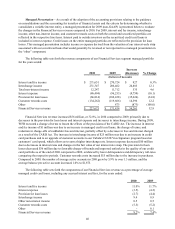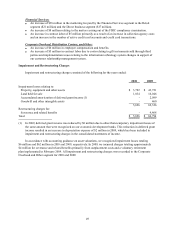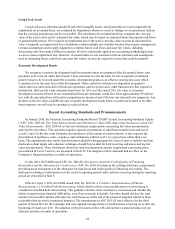Cabela's 2011 Annual Report Download - page 64
Download and view the complete annual report
Please find page 64 of the 2011 Cabela's annual report below. You can navigate through the pages in the report by either clicking on the pages listed below, or by using the keyword search tool below to find specific information within the annual report.54
Retail and Direct Business Segments – The primary cash requirements of our merchandising business
relate to capital for new retail stores, purchases of inventory, investments in our management information systems
and infrastructure, purchases of economic development bonds related to the construction of new retail stores,
and general working capital needs. We historically have met these requirements with cash generated from our
merchandising business operations, borrowing under revolving credit facilities, issuing debt and equity securities,
obtaining economic development grants from state and local governments when developing new retail stores,
collecting principal and interest payments on our economic development bonds, and from the retirement of
economic development bonds.
The cash flow we generate from our merchandising business is seasonal, with our peak cash requirements for
inventory occurring from April through November. While we have consistently generated overall positive annual
cash flow from our operating activities, other sources of liquidity are required by our merchandising business
during these peak cash use periods. These sources historically have included short-term borrowings under our
revolving credit facility and access to debt markets. While we generally have been able to manage our cash needs
during peak periods, if any disruption occurred to our funding sources, or if we underestimated our cash needs,
we would be unable to purchase inventory and otherwise conduct our merchandising business to its maximum
effectiveness, which could result in reduced revenue and profits.
On November 2, 2011, we entered into a new credit agreement providing for a $415 million revolving credit
facility that replaced our $350 million credit facility set to expire June 30, 2012. The unsecured $415 million
revolving credit facility permits the issuance of letters of credit up to $100 million and swing line loans up to $20
million. This credit facility may be increased to $500 million subject to certain terms and conditions. The term of
the credit facility expires on November 2, 2016. Advances under the credit facility will be used for the Company’s
general business purposes, including working capital support.
Our unsecured $415 million revolving credit facility and unsecured senior notes contain certain financial
covenants, including the maintenance of minimum debt coverage, a fixed charge coverage ratio, a leverage ratio,
and a minimum consolidated net worth standard. In the event that we failed to comply with these covenants,
a default would trigger and all principal and outstanding interest would immediately be due and payable. At
December 31, 2011, and January 1, 2011, we were in compliance with all financial covenants under our credit
agreements and unsecured notes. We anticipate that we will continue to be in compliance with all financial
covenants under our credit agreements and unsecured notes through at least the next 12 months.
Our $15 million Canadian dollars (“CAD”) unsecured revolving credit facility is for our operations in Canada
and expires June 30, 2013. The credit facility permits the issuance of up to $5 million CAD in letters of credit,
which reduce the overall credit limit available under the credit facility.
Financial Services Business Segment – The primary cash requirements of WFB relate to the financing
of credit card loans. These cash requirements will increase if our credit card originations increase or if our
cardholders’ balances or spending increase. WFB sources operating funds in the ordinary course of business
through various financing activities, which include funding obtained from securitization transactions, obtaining
brokered and non-brokered certificates of deposit, borrowing under its federal funds purchase agreements, and
generating cash from operations. During 2011, WFB issued $622 million in certificates of deposit, renewed its
$260 million variable funding facility for an additional three years, entered into two new variable funding facilities
for $353 million and $412 million that will mature in March 2014 and September 2014, respectively, and completed
two $300 million term securitizations that will mature in March 2014 and September 2014, respectively. In 2012,
WFB intends to issue additional certificates of deposit and additional term securitizations. We believe that these
liquidity sources are sufficient to fund WFB’s foreseeable cash requirements and near-term growth plans.
WFB is prohibited by regulations from lending money to Cabela’s or other affiliates. WFB is subject to
capital requirements imposed by Nebraska banking law and the Visa U.S.A., Inc. (“Visa”) membership rules, and
its ability to pay dividends is also limited by Nebraska and Federal banking law. If there are any disruptions in the
credit markets, our Financial Services business, like many other financial institutions, may increase its funding
from certificates of deposit which may result in increased competition in the deposits market with fewer funds
























